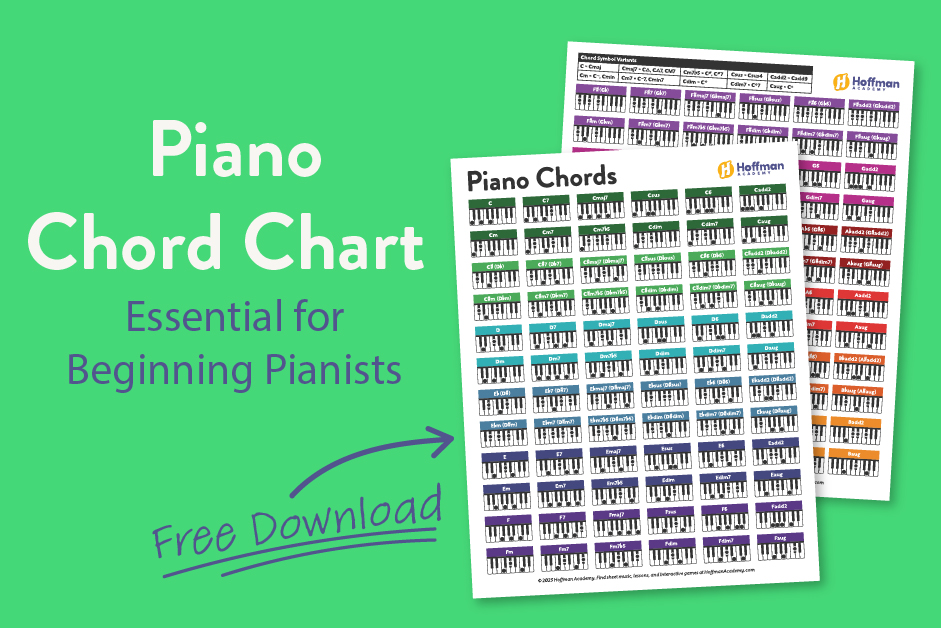

Being able to understand and use chords is extremely important when learning any type of music, including classical music, popular songs, jazz music, and so on. Our downloadable piano chord chart will help you master piano chords and be able to play many different styles of music, whether the chords are written as notation or chord symbols. Read on to learn more about how to use this piano chord chart and practice chord progressions at home!
Ready to learn all there is to know about piano chords? Our chord chart is free! Sign up for Hoffman Academy Premium today to access more piano downloads (including informational packets, flashcards, card games, and board games) and other materials to enhance your learning.
Our piano chord chart lists 144 chords, which include all major and minor triads, diminished triads, augmented triads, 7th chords, suspended chords, and more!
An important note about our piano chord chart is that the chords listed are all in root position. This means that the name of the chord is the bottom note of the chord that is being played (furthest to the left on the piano). When you play chord progressions, it may be easier to play some of the chords in 1st or 2nd position rather than root position. Below is a drawing showing what C major in root position, 1st position, and 2nd position looks like.
Students should begin learning major triads, minor triads, and simple 7th chords. These basic chords can then be reinforced by practicing simple chord progressions, such as I-IV-V7 or I-vi-IV-V7. If a student is unable to reach all of the notes in a chord progression, the chords within that chord progression can be simplified to fit the student’s hand size.
Chord progressions include both root position chords and inversions. For example, a C major root chord is played C-E-G, with the note C being the root (the name of the chord) and the lowest note played. To play an inversion you play the same notes, but in a different order, such as E-G-C or G-C-E. These are still the C major chord, just with the notes rearranged. When they’re rearranged the root is no longer the lowest note played.
Now, let’s try playing the easy I-IV-V7 chord progression using root position chords and inversions in the right hand!
If you’d like to learn more about the I-IV-V progression and other chord progressions, check out the following videos!
The key to memorizing chords on the piano is to practice them a little every day. In addition to practicing chord progressions, as outlined in the paragraph above, picking favorite pieces of music and learning the chords that it takes to perform it can be a wonderful way to commit chords to memory. Great songs to help you internalize simple chords include “Happy Birthday” , “Amazing Grace” , and “Dragon Night” .
Practicing along with practice-tracks can be really helpful in gaining mastery and memorizing these chords. If you are a premium member, you have access to these learning resources! If you’d like to sign yourself or a family member up for premium membership, check out this link today !
There are lots of different types of chords, including major and minor chords, diminished and augmented chords, and 7th and suspended chords, all of which are included in our piano chart download! This download is free from our store and you can access it here. While you are there you can find lots of other great music learning resources that are either free or low cost to download.
Now that you’ve learned a little about chords, chord progressions, resources that you can practice with, and songs that you can memorize chords with, you’re ready to download our piano chord chart! Have fun and remember that a little practice everyday can go a long way!